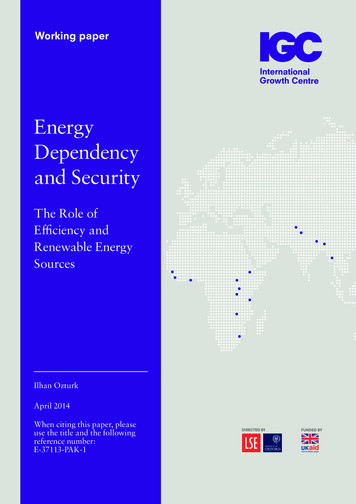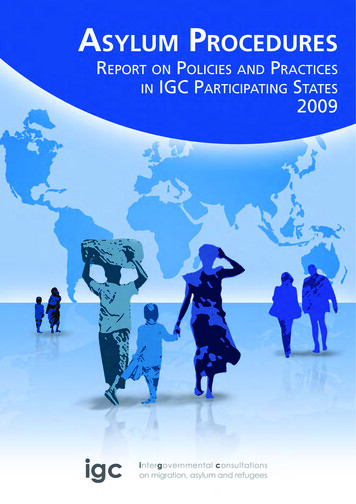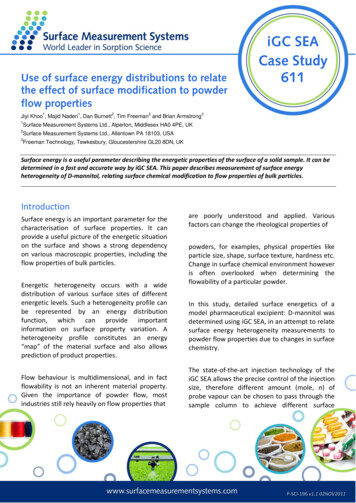
Transcription
Working paperEnergyDependencyand SecurityThe Role ofEfficiency andRenewable EnergySourcesIlhan OzturkApril 2014When citing this paper, pleaseuse the title and the followingreference number:E-37113-PAK-1
ENERGY DEPENDENCY AND ENERGY SECURITY: THE ROLE OF ENERGYEFFICIENCY AND RENEWABLE ENERGY SOURCESIlhan OZTURKFaculty of Economics and Administrative Sciences,Cag University, 33800, Mersin, Turkey.Email: ilhanozturk@cag.edu.trTel & Fax: 90 324 6514828AbstractNational and international energy policies have very important role in regional andglobal power equilibrium and its importance is increasing. In this respect, diversification ofenergy resources and their transportations routes, efficient use of local resources and the useof existing energy resources with various technological and strategic practices in the mostefficient way possible are necessary in order to improve energy security and reducedependence on foreign energy sources.Energy efficiency and renewable energy sources stand out as an important issueSespecially regarding energy supply security, reducing foreign energy dependency, economicdevelopment, maintaining the balance between environment and sustainability as well asmaking important gains in all these issues. Thus, Improving energy efficiency saves money,reduces carbon emissions and decreases your country's dependence on foreign energysupplies. Energy security – the uninterrupted availability of energy sources at an affordableprice – can also profit from improved energy efficiency by decreasing the reliance onimported fossil fuels. Possible improvements in energy efficiency are examined in six maincategories: 1) buildings, 2) industry, 3) transportation, 4) electricity generation anddistribution, 5) appliances and equipment, and 6) lighting.According to the Turkish Energy Efficiency Strategy Document (2012-2023), it wasobserved that with rational policies and technological improvements, a minimum of 20%increase is possible in energy efficiency between 2013 and 2023. In the last year, majorenergy-consuming countries also have announced new measures: China is targeting a 16%reduction in energy intensity by 2015; the United States has adopted new fuel economystandards; the European Union has committed to a cut of 20% in its 2020 energy demand; andJapan aims to cut 10% from electricity consumption by 2030.The aim of this paper is to study the importance of energy efficiency and renewableenergy sources and their roles on reducing energy dependency and promoting energy security.In addition, the energy efficiency applications of Turkey will be discussed and general energyOutlook of Pakistan and some policy implications to solve the energy crisis in Pakistan willbe presented.Keywords: Energy Efficiency, Energy Dependency, Renewable Energy, Energy Security,Turkey, Pakistan1
1. IntroductionNational and international energy policies have very important role in regional andglobal power equilibrium and its importance is increasing. In this respect, diversification ofenergy resources and their transportations routes, efficient use of local resources and the useof existing energy resources with various technological and strategic practices in the mostefficient way possible are necessary in order to improve energy security and reducedependence on foreign energy sources.All societies require energy services to meet basic human needs (e.g., lighting,cooking, space comfort, mobility, communication) and to serve productive processes. Fordevelopment to be sustainable, delivery of energy services needs to be secure and have lowenvironmental impacts. Sustainable social and economic development requires assured andaffordable access to the energy resources necessary to provide essential and sustainableenergy services. This may mean the application of different strategies at different stages ofeconomic development. To be environmentally benign, energy services must be provided withlow environmental impacts and low greenhouse gas (GHG) emissions. However, theIntergovernmental Panel on Climate Change (IPCC) Fourth Assessment Report (AR4)reported that fossil fuels provided 85%1 of the total primary energy in 2004, which is thesame value as in 2008. Furthermore, the combustion of fossil fuels accounted for 56.6% of allanthropogenic GHG emissions (CO2) in 2004. The IPCC is the leading international body forthe assessment of climate change. It was established by the United Nations EnvironmentProgramme (UNEP) and the World Meteorological Organization (WMO) to provide theworld with a clear scientific view on the current state of knowledge on climate change and itspotential environmental and socio-economic impacts.Climate change is one of the great challenges of the 21st century. Its most severeimpacts may still be avoided if efforts are made to transform current energy systems.Renewable energy sources have a large potential to displace emissions of greenhouse gasesfrom the combustion of fossil fuels and thereby to mitigate climate change. If implementedproperly, renewable energy sources can contribute to social and economic development, toenergy access, to a secure and sustainable energy supply, and to a reduction of negativeimpacts of energy provision on the environment and human health.Renewable energy is largely a domestic source of energy. When it displaces importedfuels, it contributes to greater national energy security and directly reduces import bills, whichrepresent a fairly significant percentage of gross domestic product (GDP) in many importingcountries and often contribute to a trade deficit. Renewable energy sources (such as wind,solar and biomass) have the potential to reduce these effects significantly. Moreover, greateruse of renewables could indirectly put downward pressure on oil and gas prices and reduceprice volatility. In the electricity sector, renewables mainly reduce the need to import gas orcoal, as oil use is limited in this sector.While GDP per capita and population growth had the largest effect on emissionsgrowth in earlier decades, decreasing energy intensity significantly slowed emissions growthin the period from 1971 to 2008. In the past, carbon intensity fell because of improvements inenergy efficiency and switching from coal to natural gas and the expansion of nuclear energyin the 1970s and 1980s. In recent years (2000 to 2007), increases in carbon intensity havebeen driven mainly by the expansion of coal use in both developed and developing countries,although coal and petroleum use have fallen slightly since 2007. In 2008 this trend wasbroken due to the financial crisis. Since the early 2000s, the energy supply has become morecarbon intensive, thereby amplifying the increase resulting from growth in GDP per capita.Baseline projections for the EU indicate that electricity consumption will grow onaverage by 2%/y to 2030, with a potentially slightly slower pace each year because of energyefficiency improvement measures and higher fossil fuel prices, in particular natural gas,2
which will consequently affect electricity pricing. This provides an impetus to improvetechnologies in coal- and gas-based power generation and more specifically to improvingconversion efficiency, as this would result in substantial CO2 and fuel savings. For example,each percentage point efficiency increase is equivalent to about 2.5% reduction of CO2emitted. Power plant efficiency is therefore a major factor that could be used to reduce globalCO2 emissions.Since 2008, China has become the largest emitter of GHG in the world overtaking theUnited States. Now China accounts for 25% of total global CO2 emissions, up from 11% in1990. The top five coun- tries with the highest energy related CO2 emissions in addition toChina, include USA, India, Russia and Japan, which in total represented 58% of globalemissions in 2011). Adding the cumulative emissions of the next five countries: Germany,South Korea, Iran, Canada and Saudi Arabia demonstrates that the top ten countries accountedfor slightly more than two thirds of world emissions in 2011. The largest increase has takenplace in China and India, where emissions per capita in China increased by a factor of threeand in India by 2.5 respectively, and the Middle East ( 75%), due to the high economicgrowth.In 2009, the European Union released the Renewable Energy Directive, which setlegally binding targets for the share of renewable energy (covering electricity, heat andbiofuels) in gross final energy consumption of each member state by 2020, equating to 20% intotal. To ensure that their targets are met, each country is required to prepare an action planand provide regular progress reports. Renewable energy is expected to continue to be centralto EU energy policy beyond 2020. A recent European Commission report indicated thatrenewable energy could meet 55-75% of final energy consumption by 2050, compared withless than 10% in 2010 (EC, 2011; EU, 2011). According to the Turkish Energy EfficiencyStrategy Document (2013-2023), it was observed that with rational policies and technologicalimprovements, a minimum of 20% increase is possible in energy efficiency between 2013 and2023. In addition, major energy-consuming countries also have announced new measures in2012: China is targeting a 16% reduction in energy intensity by 2015; the United States hasadopted new fuel economy standards; the European Union has committed to a cut of 20% inits 2020 energy demand; and Japan aims to cut 10% from electricity consumption by 2030.2. Energy EfficiencyEfficient energy use, sometimes simply called "energy efficiency", is the goal ofefforts to reduce the amount of energy required to provide products and services. Energyefficiency is a way of managing and restraining the growth in energy consumption. Forexample, insulating a home allows a building to use less heating and cooling energy toachieve and maintain a comfortable temperature. Installing fluorescent lights or naturalskylight reduces the amount of energy required to attain the same level of illuminationcompared to using traditional incandescent light bulbs. Compact fluorescent lights use twothirds less energy and may last 6 to 10 times longer than incandescent lights.Energy efficiency stands out as an important issue especially regarding supplysecurity, economic development and competitiveness on the one hand, and maintaining thebalance between environment and sustainability as well as making important gains in all theseissues on the other.Energy efficiency offers a powerful and cost-effective tool for achieving a sustainableenergy future. Improvements in energy efficiency can reduce the need for investment inenergy infrastructure, cut energy bills, improve health, increase competitiveness and improveconsumer welfare. Environmental benefits can also be achieved by the reduction ofgreenhouse gases emissions and local air pollution. In addition, energy efficiency reducesyour country's dependence on foreign energy supplies.3
According to World Energy Council 2013 Report, most countries have significantlyreduced their total energy use per unit of GDP over the last three decades. The decline inenergy intensity has been driven largely by improved energy efficiency in key end-uses suchas vehicles, appliances, space heating and industrial processes. Governments haveimplemented a wide range of policies and programmes such as energy efficiency standards,educational campaigns, obligations for market participants and financial incentives toaccelerate the development and adoption of energy efficiency measures. Western Europe iscurrently the region with the lowest energy intensity, while among the large consumercountries; CIS uses almost 3 times more energy per unit of GDP than Europe. In China,Africa and the Middle East, the energy intensity is two times higher than the average inEurope. High energy intensities can be attributed to a number of factors, including thestructure of the industry, the share of energy intensive sectors, low energy prices and other.Latin America and OECD Asia & Pacific are about 15% above the European level, whileIndia and other Asia are at the same level as the world average with energy intensity 50%higher than in Europe and slightly less than North America.Energy efficiency has proved to be a cost-effective strategy for building economieswithout necessarily growing energy consumption. For example, the state of California beganimplementing energy-efficiency measures in the mid-1970s, including building code andappliance standards with strict efficiency requirements. During the following years,California's energy consumption has remained approximately flat on a per capita basis whilenational U.S. consumption doubled. As part of its strategy, California implemented a "loadingorder" for new energy resources that puts energy efficiency first, renewable electricitysupplies second, and new fossil-fired power plants last.Energy conservation is broader than energy efficiency in that it encompasses usingless energy to achieve a lesser energy service, for example through behavioural change, aswell as encompassing energy efficiency. Examples of conservation without efficiencyimprovements would be heating a room less in winter, driving less, or working in a lessbrightly lit room. As with other definitions, the boundary between efficient energy use andenergy conservation can be fuzzy, but both are important in environmental and economicterms. This is especially the case when actions are directed at the saving of fossil fuels.4
Reducing energy use is seen as a key solution to the problem of reducing greenhouse gasemissions. According to the International Energy Agency (IEA), improved energy efficiencyin buildings, industrial processes and transportation could reduce the world's energy needs in2050 by one third, and help control global emissions of greenhouse gases.America is an “energy hog” and uses twice as much energy per capita as mostEuropean countries and perhaps ten times as much as most of Asia and Africa (see followingfigure).It is a result to a large extent to a greater degree of industrialization. Much of industryis energy demanding. More industrialized countries in Asia, such as Japan, China and Taiwan,use more energy than the rest of the Asian countries but not as much per capita as the U.S.More of Asia is rapidly industrializing so it is certain that its energy demands will increaseand offer more competition for energy supplies to the more energy intensive countries. Thesechanges are inevitable and relate to the increase in the quality of life associated with suchindustrialization, rising population and income. In any case, the energy needs of much of therest of the world will increase, and if this is accompanied by the increasing energy use inAmerica that we have experienced, the world’s energy requirements are bound to grow. If thisoccurs in a time of limited resources, problems will arise. There will be increasing strifeamong competitors for the available resources and increased cost, leading to a limitation ofthe rate of growth. The burden of this limitation will fall more heavily on the poorer parts ofsociety. To decrease these problems, it appears desirable to reduce the per capita energy usefor ourselves and to find ways for others to grow in a less energy intensive way. This can beaccomplished through changes in life style, finding ways for using energy more efficientlyand using altrnative energy sources such wind, solar and biomass.In addition to the possibility of diminished sources of fossil fuels, there is a problem inthe production of carbon dioxide from burning fossil fuels. The evidence is clear that thecarbon dioxide (CO2) concentration in the atmosphere has greatly increased (Weart, 2008).The increase in carbon dioxide has been accompanied by a change in the Earth’s climate. Theclimate change in turn has been ascribed to the greenhouse effect. Human activity, that hasincreased the amount of the greenhouse gases in the Earth’s atmosphere, has led to anincrease in climate warming (Physical Geography, 2009).5
It is evident that because of the limitations of fossil fuel supply and consideration ofthe environmental deterioration arising from their use, that other sources of energy should beconsidered. To secure energy supply and meet the energy demand in future, the importance ofrenewable energy (such as wind, solar and biomass) becomes even more critical.Energy security – the uninterrupted availability of energy sources at an affordableprice – can also profit from improved energy efficiency by decreasing the reliance onimported fossil fuels. Energy security is very important, especially for energy importing(energy dependent countries, such as Pakistan and Turkey) countries. Because rising inenergy prices or decreasing in energy supply will have a negative impact on the growth ofthese countries.In addition, the question of energy security also is one of the main concerns for thefuture of Europe because of the growing dependency of the European countries on thirdparties, namely Russia, for natural gas. The future of European energy security will be shapedby the EU’s dependence on Russia and its ability to find alternative sources of energy as wellas multiple routes of transport. Turkey’s location between the major energy producers in theCaspian and the major energy consumers in Europe has increased Turkey’s potential role asthe transit country.To promote energy security of Europe, Nabucco is projected to transport natural gasfrom the Caspian region through Turkey, Bulgaria, Romania and Hungary to Austria, and theCooperation Agreement was signed between these five countries in October 2002 (seefollowing figure). The Agreement signed on 13 July 2009 between these five countriesenabled the operationalization of these plans. The consortium for the pipeline, the NabuccoGas Pipeline International, was founded in 2004 with the objective of constructing a newpipeline connecting the Caspian region, the Middle East and possibly Egypt as a new supplyroute for Europe. The investment for the pipeline, which will be approximately 3,300kilometres, is estimated to cost around 8 billion Euros. Potential suppliers to the pipeline arethe Caspian states, Azerbaijan, Kazakhstan, Turkmenistan, Iran, and, if possible, Egypt andIraq as well. The major supplier for the initial stage of the Nabucco pipeline is projected to beShah Deniz fields of Azerbaijan.6
3. Turkey Energy OutlookTurkey's importance in the energy markets is growing, both as a regional energytransit hub and as a growing consumer. Turkey's energy demand has increased rapidly overthe last few years and likely will continue to grow in the futureOver the last two years, Turkey has seen the fastest growth in energy demand in theOECD, and unlike a number of other OECD countries in Europe, its economy has avoided theprolonged stagnation that has characterized much of the continent for the past few years. Thecountry's energy use is still relatively low, although it is increasing at a very fast pace.According to the International Energy Agency (IEA), energy use in Turkey is expected todouble over the next decade, while electricity demand growth is expected to increase at aneven faster pace. Meeting this level of growth will require significant investment in the energysector, much of which will come from the private sector. Large investments in natural gas andelectricity infrastructure will be essential. In addition to being a major market for energysupplies, Turkey's role as an energy transit hub is increasingly important. It is key to oil andnatural gas supplies movement from Russia, the Caspian region, and the Middle East toEurope. Turkey has been a major transit point for seaborne-traded oil and is becoming moreimportant for pipeline-traded oil and natural gas (see following figüre).In 2010 and 2011, Turkey's economy was one of the fastest growing economies in theworld, at over 8 percent annual growth rates, and with this economic expansion, Turkey's oilconsumption grew. In 2011, Turkey imported more than 90 percent of its total liquid fuelsconsumption. According to the IEA, Turkey's imports are expected to double over the nextdecade.In the following figures, the Developments in the energy demand and energy supply ofall types are given.7
Development of Primary Energy Consumption of Turkey (1980-2011)8
Development of Domestic Energy Supply and Energy Demand (1990-2011)The rate of increase of aggregate demand between 2000-20099
Annual per capita electricity Consumption for Pakistan was 449 kWh in 2011.3.1 Energy Efficiency and Applications in TurkeyTurkey, forging ahead with confident and rapid steps to become a pivotal and strongcountry in her region and the world, should aim for more efficient use of energy resources,development of deliberate policies of energy security, diversification of energy resources(using renewable energy sources), and development of new technologies. Turkey’s energyimport (mainly crude oil and natural gas) in 2011 was around 54 billion dollars, which equals%69 of the account deficit. Turkey should reduce its dependence on foreign energy sourcesand become a pioneer rather than a follower in the energy sector, especially amongdeveloping economies.Possible improvements in energy efficiency are examined in four main categories: 1)buildings, 2) industry, 3) transportation, 4) electricity generation and distribution. Dataanalyses and optimization studies lead to the following conclusions: It is estimated that asaving of 20% to 60% in yearly energy consumption can be made with efficiencyimplementations in buildings; 10% to 40% increase in efficiency can be obtained with the useof energy management systems in the industry; compared to vehicles with internalcombustion engines, electric vehicles provide 70% cost benefit and 65% decrease in CO2emission; and 16% to 28% improvements in electricity generation and distribution can beachieved with compensation, introduction of SCADA systems, and smart gridimplementations in distribution 1.As a result of the analyses were made by the academicians and government authoritiesof Turkey made, it was observed that with rational policies and technological improvements, aminimum of 20% increase is possible in energy efficiency between 2012 and 2023. Toachieve these objectives, Turkish government announced and applied the following “TurkeyEnergy Efficiency Strategy Document” in energy-efficiency-assessment-and-targets10
Turkey Energy Efficiency Strategy Document (2012- 2023) 2: It is targeted with thisdocument to decrease at least 20% of amount of energy consumed per GDP of Turkey in theyear 2023 (energy intensity).-To reduce energy intensity and energy losses in industry and services sectors-To decrease energy demand and carbon emissions of the buildings; to promote sustainableenvironment friendly buildings using renewable energy sources-To provide market transformation of energy efficient products-To increase efficiency in production, transmission and distribution of electricity, to decreaseenergy losses and harmful environment emissions-To reduce unit fossil fuel consumption of motorized vehicles, to increase share of publictransportation in highway, sea road and railroad and to prevent unnecessary fuel consumptionin urban transportation-To use energy effectively and efficiently in public sector-To strengthen institutional capacities and collaborations, to increase use of state of the arttechnology and awareness activities, to develop financial mechanisms except public financialinstitutions.-To have at least 3 operating nuclear power plantsTurkey, which continues efforts to construct nuclear power plant, aims to use 36,000 MWhydroelectric, 20,000 MW wind, 3,000 MW solar, 600 MW geothermal, 2,000 MW biomassenergy by 2023.-Turkey's renewable energy resource potential is around 136,600 MW. However, Turkey usesonly 13.6 per cent of its domestic renewable energy resources.-Turkey aims to drop natural gas' share in electricity production to 30 per cent but raiserenewable energy resource share to 30 per cent by 2023.-To increase the share of nuclear power to 5% in the electricity production.-To increase utilization of local and renewable energy sources to reduce excessivedependence on natural gas (15-20 % of energy)The envisioned goals can only be achieved with a National Energy Strategy that isfuture-oriented and holistic; has realistic objectives and measurement mechanisms; is orientedtowards local resources, manpower, scientific research and technology development; is opento global opportunities and partnerships; is shaped by active participation of all stakeholdersin the guidance of the public sector; and is implemented consistently and adamantly.Japan, Switzerland, Germany, and Denmark, which are all very successful in energyefficiency, as well as the example of the United States, which continuously puts more andmore emphasis on energy efficiency.3.2. Energy Efficiency and Energy Dependency Relationship in TurkeyLet me first point at the relationship between import dependency in energy and currentaccount deficit. Turkey is dependent on imported energy. More than 70% of energyconsumption is imported. The energy import was 38,5 billion USD (20.8% of total import) in2010 and 60,1 billion USD (25.1% of total import) in 2012.As of 2011, Turkey’s current account deficit was 10% of its GDP (see Chart 1 and 2).Turkey’s dependency on energy imports is the main driver of the current accountdeficit. Deficit in current account was considered as one of the elements of fragility in Turkisheconomy. As a result, Turkish economy had to choose between economic growth and currentaccount /Energy Efficiency Strategy Paper.pdf11
Foreign trade Developments in TurkeyAnnual (Billion )ExportEnergy ExportGold ExportImportEnergy ImportGold ImportForeign Trade VolumeForeign Trade BalanceBalance excl. EnergyExport/Import (%)Periodic (Billion Dollar)201120122012 / (JAN - FEB)2013 / (JAN - 1-14.3-6.262.7Change rt 2. Rate of Energy Import in the Total Import of Tukey (%)Because of Turkey’s dependence on external sources for energy, it is clear that anyproblem or crisis in energy supply can negatively affect the economic growth of Turkey.Thus, policies that provide energy supply security should be put into practice, which is criticalbecause of Turkey’s geographic and geopolitical location. The expansion of renewable energy12
will reduce dependence on foreign energy sources, volatile oil and natural gas prices oninternational markets, and curtail the long-run environmental degradation associated withcarbon emissions. Therefore, Turkey’s energy policies should be such that they shoulddiminish the country’s dependency for external energy sources by substituting them withrenewable energy sources of Turkey and increasing energy efficiency.Turkey, forging ahead with confident and rapid steps to become a pivotal and strongcountry in her region and the world, should aim for more efficient use of energy resources,development of deliberate policies of energy security, diversification of energy resources(using renewable energy sources) and development of new technologies. Turkey shouldreduce its dependence on foreign energy sources and become a pioneer rather than a followerin the energy sector, especially among developing economies.By increasing energy efficieny in Turkey, the energy dependency will be reduced andthis will decreases the energy import and finally the current account deficit will be reduced.As a result, with energy efficiency policies current account deficit of Turkey can be decreasedat least by 30%. In other words, current account deficit/GDP ratio can be decrased to 4-5%from 8%. Of course energy efficiency is one of the factor that will decrease the current accoutdeficit. The others are to export high value added products, increasing FDI and tourismrevenues.4. Pakistan Energy OutlookThe economy of Pakistan recovered modestly in 2012 compared to 2011. However,the overall economic outlook continues to be marked by low growth and high inflationimposed by energy shortages, security issues, and macroeconomic imbalances. Pakistan'sinability to meet domestic energy demand has resulted in electricity outages, which is a keypolitical and economic issue in the country. Thus, securing energy supply sources of naturalgas, oil, hydro, and coal will be critical for Pakistan’s economic growth.According to International Energy Agency and Asian Development Bank reports, theprimary energy demand for Pakistan is projected to increase from 84.6 million tons in 2010 to145.8 million tons in 2035, growing at an annual rate of 2.2 percent. With this growth,Pakistan’s per capita energy demand will reach 0.59 tons per person as compared to that of0.49 tons in 2010.13
14
Dry natural gas production has grown by more than 70 percent over the past decadefrom 809 billion cubic feet (Bcf) in 2002 to 1,383 Bcf in 2011, all of which was domesticallyconsumed. Despite the growth of natural gas production, the country's demand is stillconstrained. Pakistan currently does not import natural gas because it lacks the infrastructure.Pakistan is self-sufficient in natural gas — the main energy source to meet its primary energydemand — while domestic production will decline from the current 38.4 billion cubic metres(bcm) to 13 bcm in 2035 and Pakistan will have to start importing natural gas sometime after2015.Electricity net consumption has increased from 47 billion kilowatthours (KWh) in2000 to 74 billion KWh in 2010. According to the latest World
Ilhan OZTURK Faculty of Economics and Administrative Sciences, Cag University, 33800, Mersin, Turkey. Email: ilhanozturk@cag.edu.tr Tel & Fax: 90 324 6514828 Abstract National and international energy policies have very important role in regional and global power equilibrium and its importance is increasing. In this respect, diversification of










